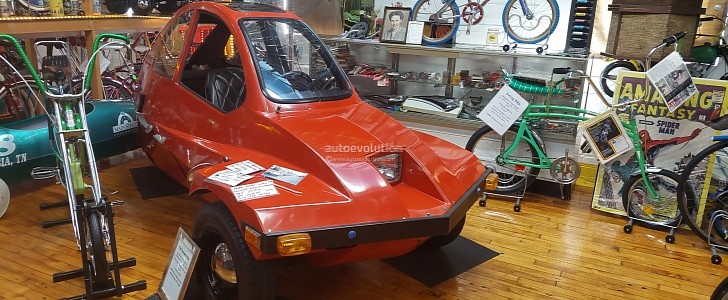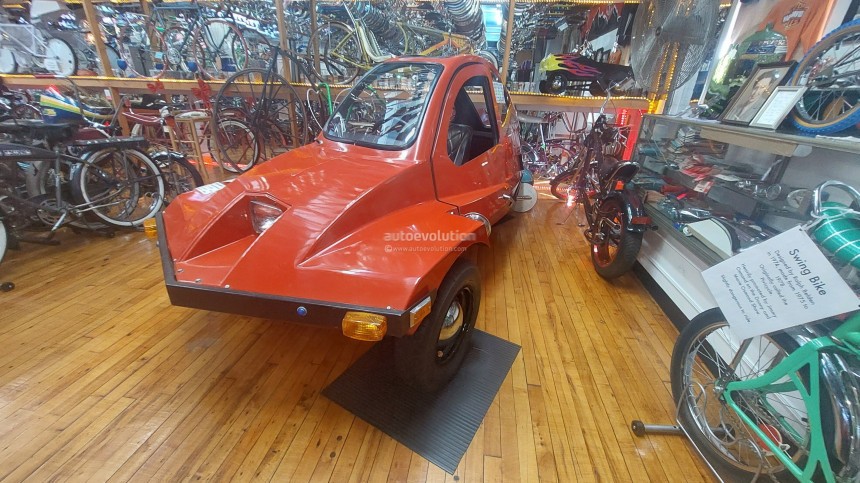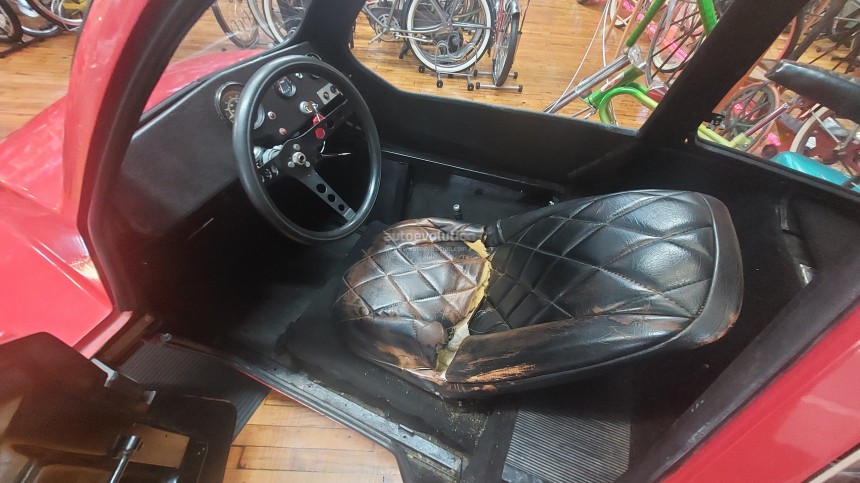You know something? One has to wonder what the world would look like if America had decided not to adopt a "no displacement for displacement" attitude to their motor vehicles. By association, you can only wonder what the roads of America would look like had we gone in the exact opposite direction as the Europeans and the Japanese did.
If that were to have happened, perhaps These United States would be covered from sea to shining sea in cars that bear at least a passable resemblance to one of these, the HM Vehicles Free-way. A car was built for a generation that wouldn't come to exist until 40 years after it went out of production. It's very easy to get the wrong impression of this positively adorable microcar. Especially this one, as it happens to reside in a bicycle museum of all places.
But no, the Free-way is not pedal-powered. It's a good old-fashioned gas-powered ICE vehicle made in Burnsville, Minnesota, from 1979 to 1982, under the supervision of lead designer Dave Edmonson. In the days before we could take EV technology for granted (i.e., right this very second), there was no way you were going to make an electric motor powerful enough to fit in a food blender to fit in something this small. Reports do exist of a four-horsepower DC electric motor being trialed on the Free-way platform. Although, it's safe to call something that pitifully underpowered a funky-looking golf cart.
A selection of either a 345 cc single-cylinder engine or a lager 453 cc unit jetting 12 and 16 horsepower, respectively, both from the Tecumseh Products Company of Ann Arbor, Michigan, was on offer instead. With paltry dimensions of 115-inches (292-cm) long, 53-inches (135-cm) wide, and 51-inches (130-cm) tall, this makes a modern Smart ForTwo look like an extended wheelbase Chevy Suburban.
With a trademark singular front headlamp, this little car is one coat of green paint and a legal permit from Disney Pixar from cosplaying as Mike Wazowski from Monsters Inc. This feature was implemented to comply with Federal regulations allowing citizens with only a motorcycle's license to be able to drive these road-legal microcars on public interstates without a trip to the DMV.
Underneath the flimsy-looking bodywork, the Free-way's chassis was comprised of tubular steel with a secondary perimeter sub-frame allowing for some degree of crumple-zone protection in the event of an accident. Unlike the Ford Mustang of similar vintage, the Free-way sported independent suspension all around with two wheels in the front and one in the rear.
Interestingly, across the pond at this time, Reliant was still building the Reliant Robin, which used an opposite wheel layout. As a result, the Robin rolled over if you breathed on it sufficiently while the Free-way stayed stable at speeds up to 80 miles per hour (128.75 kph).
With a two-piece fiberglass body no more than 3.2 millimeters thick, it made for a car so light that the base 12 hp model could easily maintain 100 miles per gallon when consistently moving at 40 miles per hour (64 kph). A ten-gallon fuel tank was an optional extra. In an unexpected stroke of forward-thinking, the Free-way was one of the first American cars to utilize a CVT transmission, a unit carried over from a snowmobile.
Inside the cockpit, there's a sense the Diamon pattern stitched leatherette-covered driver's seat took up most of the budget of the R&D for the interior of this car. A bare steering wheel with a tiny red horn button off to the side could only have been the cheaper option as well. Apart from this, there's a non-moving sunroof, your speedometer and fuel gauge, a hand brake lever, some pedals, and that's about it.
It's about as Spartan as could possibly be in here. In a way, it's almost admirable. Considering some pretty shameless small cars which try to convince you they're somehow discount luxury cars these days. It's about as genuine in its intentions as any automobile ever made. Had the first gas crisis of the early 1970s lasted any longer, it's entirely possible we could have been driving around in little microcars of the Free-way's type instead of endless Rams, Corollas, and Civics.
Want one of these vintage microcars for yourself? Good luck finding one. Only 700 or so were ever made, but this one sits already sold on display at the Bicycle Heaven Museum in Pittsburgh, Pennsylvania, in case you justy have to see one in person.
But no, the Free-way is not pedal-powered. It's a good old-fashioned gas-powered ICE vehicle made in Burnsville, Minnesota, from 1979 to 1982, under the supervision of lead designer Dave Edmonson. In the days before we could take EV technology for granted (i.e., right this very second), there was no way you were going to make an electric motor powerful enough to fit in a food blender to fit in something this small. Reports do exist of a four-horsepower DC electric motor being trialed on the Free-way platform. Although, it's safe to call something that pitifully underpowered a funky-looking golf cart.
A selection of either a 345 cc single-cylinder engine or a lager 453 cc unit jetting 12 and 16 horsepower, respectively, both from the Tecumseh Products Company of Ann Arbor, Michigan, was on offer instead. With paltry dimensions of 115-inches (292-cm) long, 53-inches (135-cm) wide, and 51-inches (130-cm) tall, this makes a modern Smart ForTwo look like an extended wheelbase Chevy Suburban.
With a trademark singular front headlamp, this little car is one coat of green paint and a legal permit from Disney Pixar from cosplaying as Mike Wazowski from Monsters Inc. This feature was implemented to comply with Federal regulations allowing citizens with only a motorcycle's license to be able to drive these road-legal microcars on public interstates without a trip to the DMV.
Interestingly, across the pond at this time, Reliant was still building the Reliant Robin, which used an opposite wheel layout. As a result, the Robin rolled over if you breathed on it sufficiently while the Free-way stayed stable at speeds up to 80 miles per hour (128.75 kph).
With a two-piece fiberglass body no more than 3.2 millimeters thick, it made for a car so light that the base 12 hp model could easily maintain 100 miles per gallon when consistently moving at 40 miles per hour (64 kph). A ten-gallon fuel tank was an optional extra. In an unexpected stroke of forward-thinking, the Free-way was one of the first American cars to utilize a CVT transmission, a unit carried over from a snowmobile.
Inside the cockpit, there's a sense the Diamon pattern stitched leatherette-covered driver's seat took up most of the budget of the R&D for the interior of this car. A bare steering wheel with a tiny red horn button off to the side could only have been the cheaper option as well. Apart from this, there's a non-moving sunroof, your speedometer and fuel gauge, a hand brake lever, some pedals, and that's about it.
Want one of these vintage microcars for yourself? Good luck finding one. Only 700 or so were ever made, but this one sits already sold on display at the Bicycle Heaven Museum in Pittsburgh, Pennsylvania, in case you justy have to see one in person.









